The Plant Kingdom, scientifically known as Kingdom Plantae, is a fundamental category in the biological classification system, which encompasses all plant life on Earth. As one of the five kingdoms in the classification system proposed by R.H. Whittaker in 1969, the Plant Kingdom is vast and diverse, containing organisms that are primarily multicellular, eukaryotic, and capable of photosynthesis. This kingdom is pivotal to life on Earth, providing oxygen, food, and shelter to countless other species, including humans.
Table of Contents
Plants, ranging from simple algae to complex flowering plants, exhibit a wide array of structures, reproductive methods, and adaptations that have allowed them to colonize nearly every environment on the planet. The study of these organisms not only deepens our understanding of life but also highlights the intricate connections between different forms of life on Earth.
Characteristics of Kingdom Plantae
Organisms within Kingdom Plantae share several defining characteristics that distinguish them from other kingdoms, such as Animalia, Fungi, and Protista. These characteristics include:
- Multicellular Eukaryotes: All members of the Plant Kingdom are composed of multiple cells that have a defined nucleus and organelles, distinguishing them from prokaryotes like bacteria.
- Autotrophic Nutrition: Plants are primarily autotrophs, meaning they synthesize their own food through the process of photosynthesis. This is facilitated by the presence of chloroplasts containing the green pigment chlorophyll, which captures light energy to convert carbon dioxide and water into glucose and oxygen.
- Non-Motile Nature: Unlike animals, plants are generally sessile, meaning they remain anchored in one place throughout their life cycle. This immobility is supported by their root systems, which secure them to the ground.
- Alternation of Generations: Plants exhibit a life cycle known as alternation of generations, where they alternate between a haploid gametophyte stage and a diploid sporophyte stage. This cycle is crucial for their reproduction and the maintenance of genetic diversity.
- Storage of Food as Starch: Plants store their excess food in the form of starch, a complex carbohydrate, which serves as an energy reserve.
- Reproductive Methods: Plants reproduce both sexually and asexually. Sexual reproduction involves the fusion of male and female gametes, while asexual reproduction can occur through various methods, such as vegetative propagation, where new plants grow from parts of the parent plant.
Types of Plant Classification
The classification of plants within Kingdom Plantae has evolved over time, with traditional systems being replaced by more modern, genetic-based systems. Historically, plants were classified based on their structural and reproductive characteristics into two main subkingdoms: Cryptogamae and Phanerogamae.
Cryptogamae and Phanerogamae
- Cryptogamae: This subkingdom includes plants that do not produce visible reproductive structures like seeds, hence they are often referred to as lower plants or seedless plants. Cryptogams are divided into three divisions: Thallophyta, Bryophyta, and Pteridophyta.
- Phanerogamae: In contrast, Phanerogams are plants that produce seeds, often called seed plants. This subkingdom includes one division: Spermatophyta, which is further divided into Gymnosperms and Angiosperms.
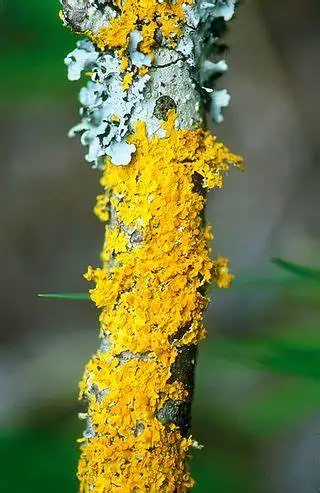
In modern times, plants are classified into various subgroups based on the presence or absence of specific features such as the vascular system, seed formation, and the differentiation of the plant body.
Classification of Kingdom Plantae
The classification of the Plant Kingdom can be further broken down into several divisions, each representing a distinct group of plants with unique characteristics. Below is a detailed exploration of these divisions:
Thallophytes (Division Thallophyta)
Thallophytes are the simplest plants in the Plant Kingdom, primarily consisting of algae. These plants are autotrophic and are predominantly found in aquatic environments. Algae play a critical role in the ecosystem by fixing carbon dioxide and producing oxygen. They are also the primary producers in many aquatic food chains.
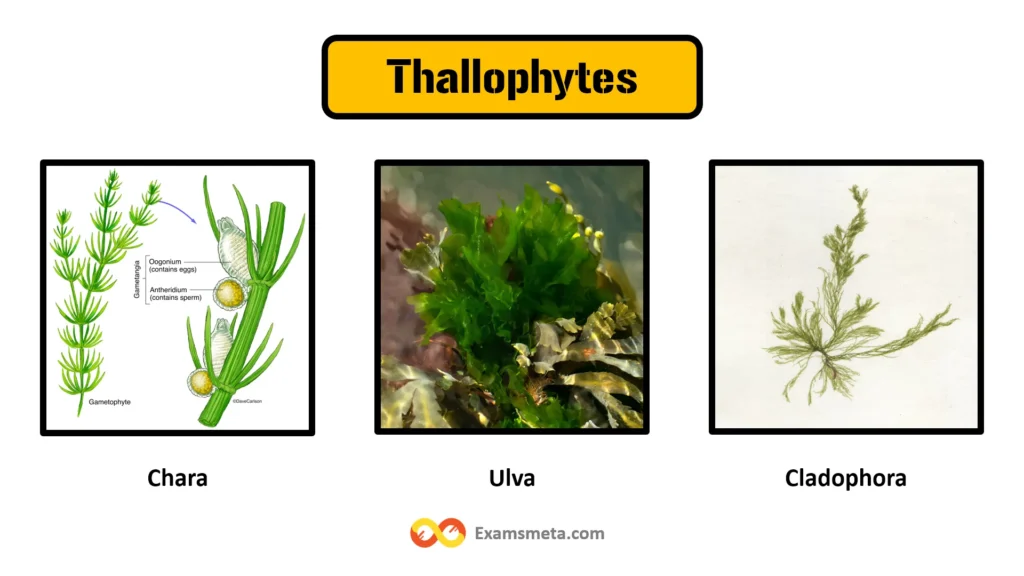
Characteristics of Thallophytes:
- Simple Body Structure: Thallophytes lack a true stem, root, or leaves, and their body is often referred to as a thallus.
- Reproduction: Thallophytes reproduce asexually through zoospores (motile spores) and sexually through the fusion of gametes, which can be either isogamous (similar gametes) or anisogamous (dissimilar gametes).
- Pigmentation: Depending on the pigments present, algae are classified into Chlorophyceae (green algae), Rhodophyceae (red algae), and Phaeophyceae (brown algae).
Examples: Volvox, Ectocarpus, Red Algae (such as Gelidium), and Chlamydomonas.
Bryophytes (Division Bryophyta)
Bryophytes are known as the amphibians of the plant kingdom because they require water for fertilization. This division includes mosses and liverworts, which are simple, non-vascular plants often found in moist, shady environments.
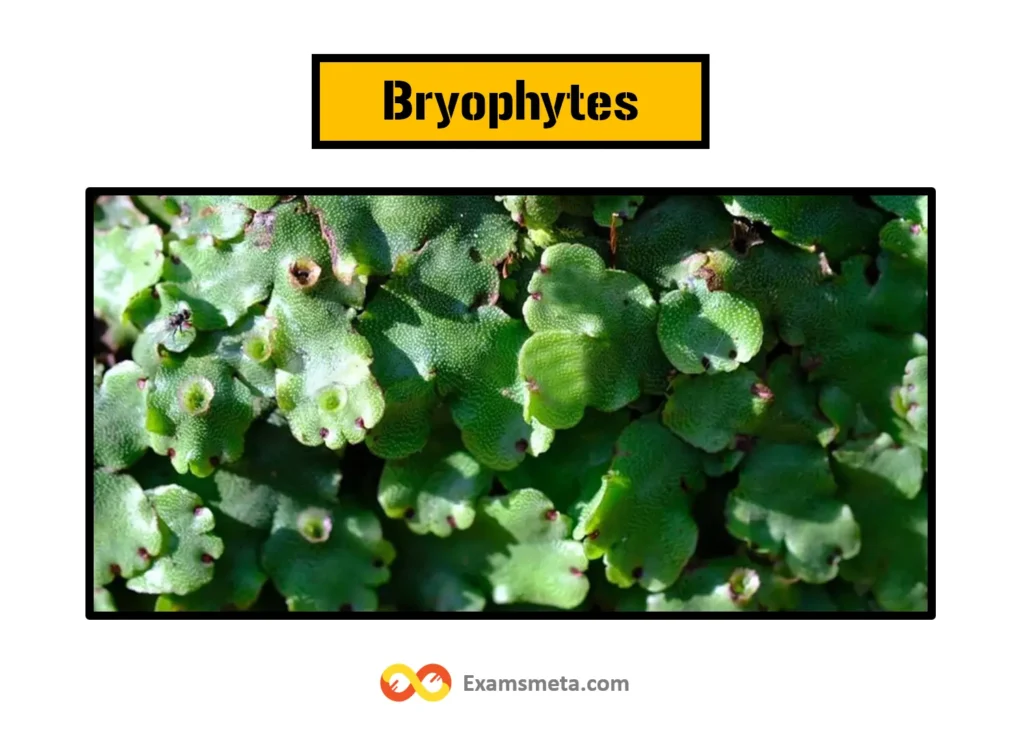
Characteristics of Bryophytes:
- Lack of Vascular Tissue: Bryophytes do not have true vascular tissue (xylem and phloem), so they rely on diffusion for water and nutrient transport.
- Dominant Gametophyte: The main plant body is a haploid gametophyte, which is the dominant stage in the life cycle. The sporophyte is dependent on the gametophyte for nourishment.
- Reproductive Structures: The male reproductive organ is called an antheridium, while the female organ is the archegonium. Fertilization occurs when water allows the sperm to swim to the egg, resulting in the formation of a diploid zygote, which develops into the sporophyte.
Examples: Sphagnum (peat moss), Marchantia, Funaria, and Riccia.
Pteridophytes (Division Pteridophyta)
Pteridophytes are the first group of plants to have developed a vascular system for the transport of water and nutrients. This division includes ferns and horsetails, which are often found in shaded, moist environments.
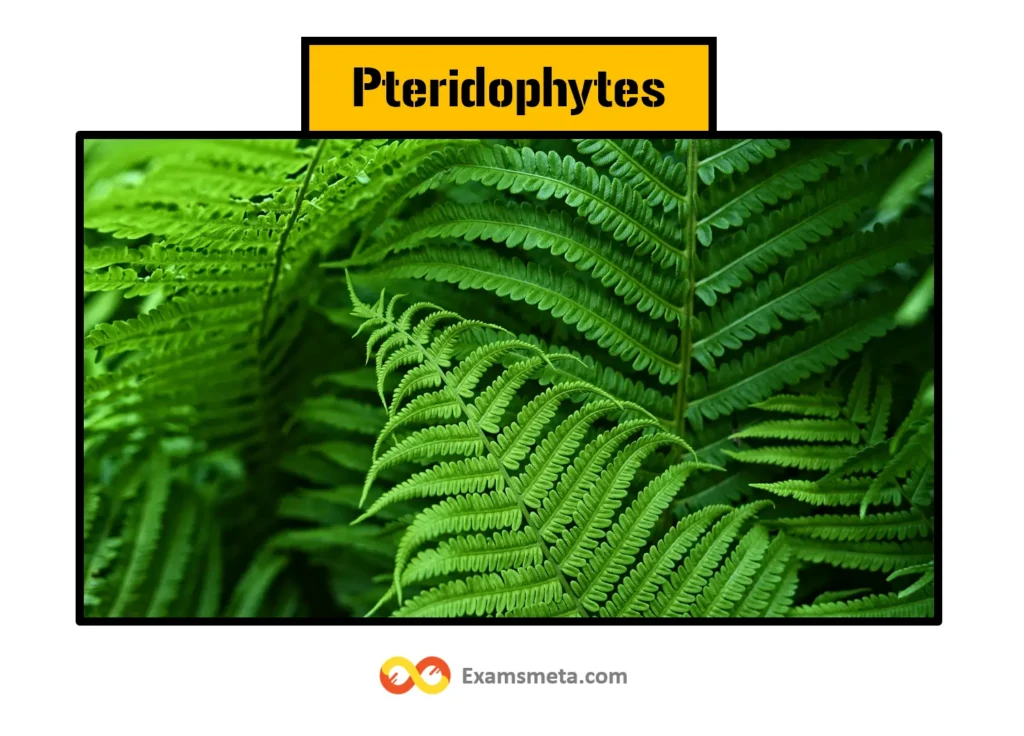
Characteristics of Pteridophytes:
- True Vascular Tissue: Pteridophytes possess well-developed xylem and phloem, allowing them to grow larger and survive in a variety of habitats.
- Dominant Sporophytes: The dominant stage in their life cycle is the diploid sporophyte, which produces spores. These spores germinate to form a prothallus, the gametophyte stage.
- Reproductive Methods: Pteridophytes reproduce via spores, which are often dispersed by wind. The gametophyte develops sex organs (antheridia and archegonia) that produce gametes, leading to fertilization and the formation of a new sporophyte.
Examples: Selaginella, Equisetum (horsetail), Pteris (fern), and Salvinia.
Gymnosperms (Division Gymnospermae)
Gymnosperms are seed-producing plants that are characterized by naked seeds (seeds not enclosed in a fruit). This group includes some of the largest and oldest living plants on Earth, such as conifers.
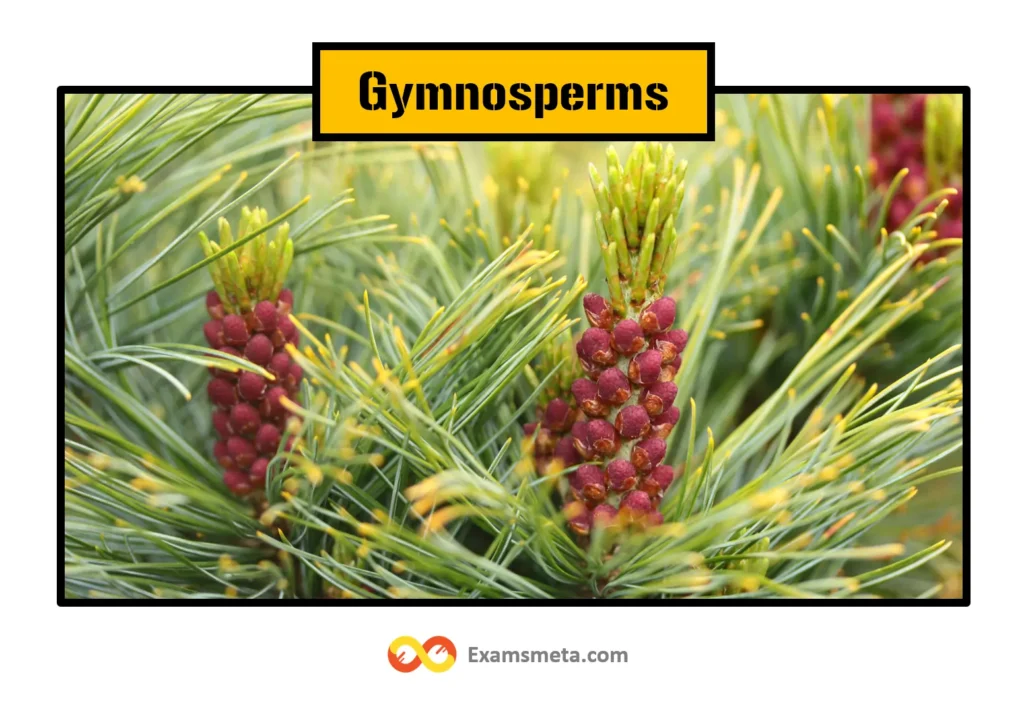
Characteristics of Gymnosperms:
- Woody, Perennial Plants: Gymnosperms are typically woody plants that can be either trees or shrubs. They are perennial, meaning they live for several years.
- Naked Seeds: The seeds of gymnosperms are not enclosed within an ovary; instead, they are exposed on the surface of cone scales or other structures.
- Vascular System: Gymnosperms have a well-developed vascular system, which includes the xylem and phloem for the efficient transport of water and nutrients.
- Heterosporous Nature: Gymnosperms produce two types of spores: microspores (which develop into male gametophytes) and megaspores (which develop into female gametophytes).
Examples: Pinus (pine), Ginkgo biloba (maidenhair tree), Cycas, and Sequoia (redwood).
Angiosperms (Division Angiospermae)
Angiosperms represent the most advanced and diverse group of plants in the Plant Kingdom. They are also known as flowering plants, as their reproductive structures are organized into flowers. Angiosperms are crucial to ecosystems and human agriculture, providing food, medicine, and other resources.
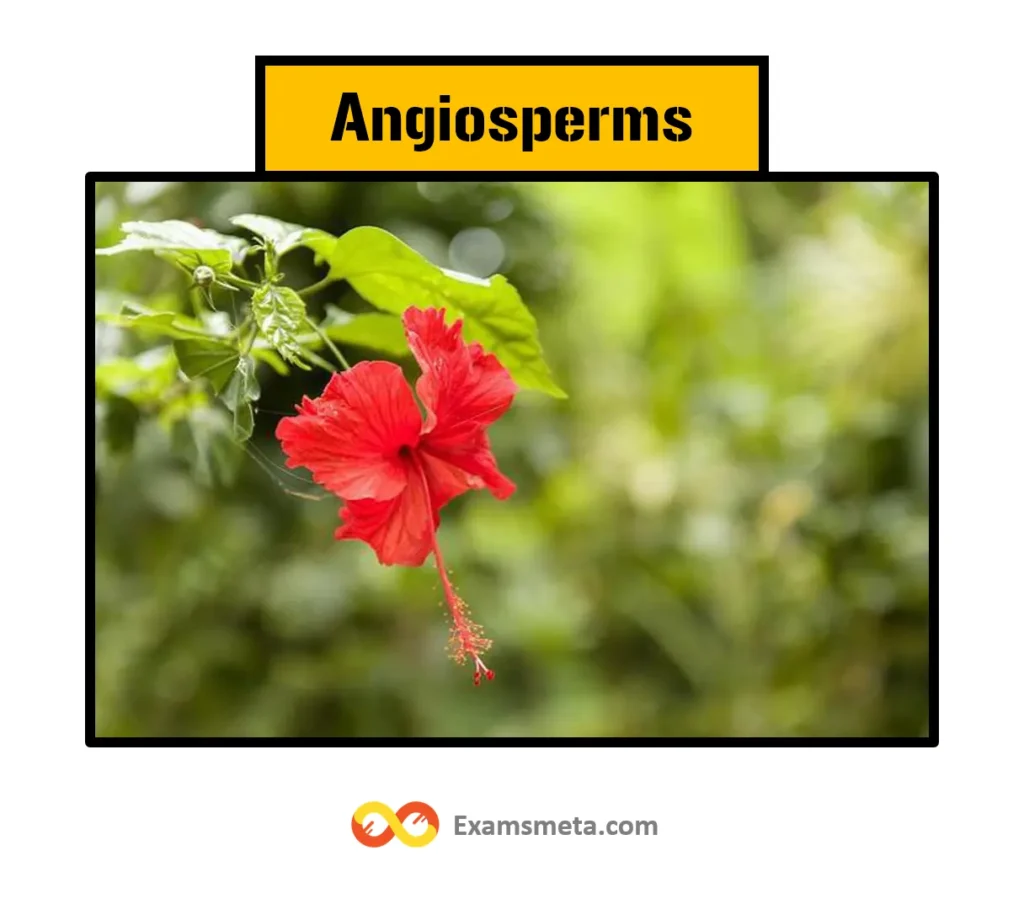
Characteristics of Angiosperms:
- Enclosed Seeds: In angiosperms, seeds are enclosed within a fruit, which develops from the ovary of the flower after fertilization.
- Diverse Forms: Angiosperms exhibit a wide range of forms, from tiny herbs like Wolffia (the smallest flowering plant) to towering trees like Eucalyptus.
- Double Fertilization: Angiosperms undergo a unique process called *double fertilization*, where one sperm fertilizes the egg to form the zygote, while another sperm fuses with two polar nuclei to form a triploid endosperm, which nourishes the developing embryo.
- Monocotyledons and Dicotyledons: Angiosperms are further classified into monocots (plants with one seed leaf or cotyledon) and dicots (plants with two seed leaves).
Examples: Wheat (monocot), Lily (monocot), Rose (dicot), Apple (dicot), Mango, Lotus, and Sunflower.
Monocotyledons vs. Dicotyledons
One of the most fundamental distinctions within the angiosperms is between monocotyledons (monocots) and dicotyledons (dicots). This classification is based on several key characteristics:
Monocotyledons (Monocots):
- Single Cotyledon: Monocots possess only one cotyledon, or seed leaf, in their seeds.
- Parallel Venation: The leaves of monocots typically exhibit parallel venation, where the veins run parallel to each other.
- Floral Structure: Monocots often have floral parts in multiples of three.
- Examples: Wheat, Lily, Palm, Rice, and Corn.
Dicotyledons (Dicots):
- Two Cotyledons: Dicots have two cotyledons in their seeds.
- Reticulate Venation: The leaves of dicots usually show reticulate venation, where the veins form a branching network.
- Floral Structure: Dicots typically have floral parts in multiples of four or five.
- Examples: Rose, Sunflower, Pea, Apple, Maple, and Oak.
Here is a detailed table highlighting the key differences between Monocotyledons (Monocots) and Dicotyledons (Dicots):
| Characteristic | Monocotyledons (Monocots) | Dicotyledons (Dicots) |
|---|---|---|
| Number of Cotyledons | One cotyledon | Two cotyledons |
| Leaf Venation | Parallel venation (veins run parallel) | Reticulate venation (veins form a network) |
| Root System | Fibrous root system (many thin roots) | Taproot system (one main root with smaller lateral roots) |
| Vascular Bundle Arrangement in Stem | Scattered vascular bundles | Vascular bundles arranged in a ring |
| Flower Parts | Floral parts in multiples of three (e.g., 3, 6, 9) | Floral parts in multiples of four or five (e.g., 4, 5, 10) |
| Pollen Structure | Pollen grains with a single aperture (monosulcate) | Pollen grains with three apertures (trisulcate) |
| Growth Pattern | Mostly herbaceous (non-woody) | Can be herbaceous or woody |
| Examples | Grasses (e.g., wheat, corn), lilies, orchids, palms | Roses, beans, sunflowers, oaks, maples |
| Secondary Growth | Usually absent; no true wood formation | Common, especially in woody plants; leads to wood and bark formation |
| Stem Structure | Lacks a distinct cortex and pith; vascular bundles scattered | Distinct cortex and pith; vascular bundles arranged in a ring |
| Embryo Structure | Embryo with one cotyledon | Embryo with two cotyledons |
| Leaf Attachment | Often sessile (without a petiole) | Often with a petiole (leaf stalk) |
| Stomata Arrangement | Stomata arranged in parallel rows on the leaf surface | Stomata scattered or arranged irregularly on the leaf surface |
| Seed Germination | Hypogeal germination (cotyledon remains underground) | Epigeal or hypogeal germination (cotyledon may or may not emerge) |
| Presence of Cambium | Absent; no secondary growth | Present in many species, allowing secondary growth |
This table provides a clear comparison between Monocotyledons and Dicotyledons, highlighting their differences in various structural, physiological, and reproductive aspects.
Additional Insights into the Plant Kingdom
The Role of Plants in the Ecosystem
Plants play a critical role in maintaining the balance of ecosystems. Through photosynthesis, they convert carbon dioxide into oxygen, which is essential for the survival of aerobic organisms, including humans. They also form the base of most food chains, providing energy for herbivores, which in turn support carnivores and omnivores.
In addition to their role in oxygen production and food chains, plants are integral to the water cycle. They absorb water from the soil through their roots and release it into the atmosphere through a process called transpiration. This release of water vapor helps in the formation of clouds and precipitation, contributing to the global water cycle.
Medicinal and Economic Importance of Plants
Plants are not only vital to ecosystems but also to human society. Many plants have medicinal properties and have been used in traditional and modern medicine for centuries. For example:
- Willow Bark: Contains salicin, which is used to produce aspirin.
- Cinchona Tree: The bark of this tree contains quinine, which is used to treat malaria.
- Foxglove: The plant Digitalis provides digoxin, a medication used to treat heart conditions.
In addition to their medicinal value, plants are economically important. They provide raw materials for various industries, including timber, paper, textiles, and food. Crops like wheat, rice, and maize are staple foods for a significant portion of the global population, while fruits and vegetables are vital sources of vitamins and minerals.
The Evolutionary Journey of Plants
The evolution of plants is a story of adaptation and survival, beginning with simple algae in the oceans and leading to the complex flowering plants that dominate the terrestrial landscape today. Bryophytes represent an early stage in plant evolution, as they made the transition from water to land, but still required moist environments for reproduction.
Pteridophytes marked a significant evolutionary step with the development of a vascular system, allowing them to grow larger and inhabit a wider range of environments. The evolution of seeds in Gymnosperms provided a new level of protection and nourishment for the developing embryo, giving these plants an advantage in harsh conditions.
Finally, the emergence of flowers in Angiosperms revolutionized plant reproduction, allowing for more efficient pollination and seed dispersal, leading to the incredible diversity of flowering plants we see today.
Conclusion
The Plant Kingdom is a cornerstone of life on Earth, providing the foundation for ecosystems, sustaining the atmosphere, and offering countless resources for human use. From the simplest algae to the most complex flowering plants, the diversity and complexity of Kingdom Plantae reflect the remarkable adaptability and resilience of plant life. Understanding the Plant Kingdom not only enriches our knowledge of biology but also underscores the importance of conservation and sustainable practices to protect these vital organisms for future generations.
Informative Table Based on Plant Kingdom
To better understand the vast diversity and complexity of the Plant Kingdom, the following table provides a detailed comparison of the major divisions within Kingdom Plantae. This table highlights key characteristics, examples, and important details that distinguish each division, offering a clear and concise overview of the plant world.
| Division | Key Characteristics | Reproduction | Examples |
|---|---|---|---|
| Thallophyta | – Simple, autotrophic, mostly aquatic – Lack of true roots, stems, or leaves | – Asexual reproduction via zoospores – Sexual reproduction through fusion of gametes (Isogamous or Anisogamous) | Volvox, Ectocarpus, Red Algae, Chlamydomonas |
| Bryophyta | – Non-vascular, lacks true roots, stems, or leaves – Require water for fertilization | – Dominant gametophyte stage – Male (antheridium) and female (archegonium) organs produce gametes | Sphagnum, Marchantia, Funaria |
| Pteridophyta | – First vascular plants – True roots, stems, and leaves – Found in shaded, moist environments | – Dominant sporophyte stage – Reproduce via spores, which germinate into gametophyte (prothallus) | Selaginella, Equisetum, Pteris, Salvinia |
| Gymnospermae | – Woody, perennial plants – Naked seeds (not enclosed in fruit) – Well-developed vascular system | – Heterosporous (microspores and megaspores) – Seeds exposed on cones or other structures | Pinus, Ginkgo biloba, Cycas, Sequoia |
| Angiospermae | – Most advanced and diverse group – Seeds enclosed within a fruit – Flowering plants | – Double fertilization – Further classified into monocots and dicots | Wheat, Lily, Rose, Apple, Mango |
| Monocotyledons | – Single cotyledon – Parallel venation – Floral parts in multiples of three | – Seeds have one cotyledon | Wheat, Lily, Palm |
| Dicotyledons | – Two cotyledons – Reticulate venation – Floral parts in multiples of four or five | – Seeds have two cotyledons | Rose, Sunflower, Pea, Apple |
This table serves as a comprehensive guide to understanding the major divisions within the Plant Kingdom, providing key insights into their characteristics, reproduction methods, and representative examples.
Related Articles
- Exploring the Complex World of Viruses, Viroids, Prions, & Lichens
- Kingdom Animalia: Definition, Classification, And Characteristics
- Kingdom Plantae: A Comprehensive Overview of the Plant Kingdom
- The Deuteromycetes: A Comprehensive Study Of Imperfect Fungi
- Basidiomycetes: A Comprehensive Study Of Club Fungi
- Ascomycetes – A Detailed Exploration Of Characteristics, Reproduction, And Importance
- Phycomycetes: A Detailed Exploration Of The Lower Fungi
- Kingdom Fungi: A Comprehensive Exploration
- Protozoans: Structure, Classification, Characteristics, And Examples
- Slime Moulds: A Comprehensive Overview
- Euglenoid: The Unique Plant-Animal Hybrid
- Dinoflagellates: The Whirling Protists of the Oceans
- Chrysophytes: A Detailed Exploration Of Their Classification, Characteristics, & Significance
- Eubacteria: Structure, Characteristics, Classification, And Types
- Archaebacteria: A Glimpse Into Ancient Life Forms
- Kingdom Protista: A Diverse Group Of Single-Celled Eukaryotes
- The Diversity And Importance Of Bacteria: Archaebacteria And Eubacteria
- Kingdom Monera: The World Of Bacteria
- The Evolution Of Biological Classification Systems
- Understanding Taxonomy, Taxonomic Categories And Hierarchy
- The Diversity Of Life: Understanding Taxonomy, Classification, And Systematics
Read More Articles
- The Fascinating Composition of an Atom: Exploring the Building Blocks of Matter
- Comprehensive Guide to Stoichiometry: Concepts, Calculations, & Real-Life Applications
- Comprehensive Guide to Percentage Composition in Chemistry
- Understanding the Mole Concept: A Comprehensive Guide
- Gram Atomic Mass and Gram Molecular Mass: A Comprehensive Guide
- Dalton’s Atomic Theory: An Interesting Groundbreaking Scientific Concept
- Laws of Chemical Combination: The Foundations of Chemical Reactions
- Understanding Measurement Uncertainty in Chemistry with Perfect Explanation
- Properties of Matter: An In-Depth Exploration
- Understanding Matter: States, Properties, and Beyond
- The Importance of Chemistry in Everyday Life
Frequently Asked Questions (FAQs) About the Plant Kingdom
What is the Plant Kingdom?
The Plant Kingdom, also known as Kingdom Plantae, is one of the fundamental classifications in the biological taxonomy system. It encompasses all multicellular eukaryotic organisms that are primarily autotrophic, meaning they can produce their own food through photosynthesis. This kingdom includes a wide variety of organisms ranging from simple algae to complex flowering plants (angiosperms). Members of the Plant Kingdom are distinguished by their ability to synthesize food using sunlight, water, and carbon dioxide, thanks to the presence of chlorophyll in their cells.
How is the Plant Kingdom classified?
The Plant Kingdom is classified into various divisions based on characteristics such as the presence of a vascular system, seed formation, and the complexity of the plant body. The major divisions include:
- Thallophyta: Simple, non-vascular plants like algae.
- Bryophyta: Non-vascular plants like mosses and liverworts.
- Pteridophyta: Vascular plants without seeds, such as ferns.
- Gymnospermae: Vascular plants with naked seeds, such as conifers.
- Angiospermae: Vascular plants with seeds enclosed in fruits, such as flowering plants.
What are the main characteristics of the Plant Kingdom?
Key characteristics of the Plant Kingdom include:
- Multicellularity: All plants are multicellular organisms.
- Eukaryotic cells: Plants have complex cells with a defined nucleus and organelles.
- Autotrophic nutrition: Plants produce their own food through photosynthesis.
- Non-motility: Plants are generally immobile, anchored to a single spot by their root system.
- Reproductive diversity: Plants can reproduce both sexually and asexually.
- Chlorophyll presence: Plants have chlorophyll pigments within chloroplasts for capturing light energy.
What is the difference between Cryptogams and Phanerogams?
Cryptogams are plants that do not have visible reproductive structures like seeds. They include divisions like Thallophyta, Bryophyta, and Pteridophyta. Phanerogams, on the other hand, have clearly visible reproductive structures, primarily in the form of seeds, and are represented by Gymnosperms and Angiosperms. While cryptogams are often considered lower plants due to their simpler structures, phanerogams are more complex and include the majority of terrestrial plants.
What are Thallophytes?
Thallophytes are a group of simple plants that lack true roots, stems, and leaves. They belong to the division Thallophyta and include organisms like algae. Thallophytes are primarily found in aquatic environments, though some can live in moist terrestrial habitats. These plants can be unicellular or multicellular and reproduce through vegetative reproduction, asexual reproduction via zoospores, or sexual reproduction through the fusion of gametes.
What are Bryophytes?
Bryophytes are known as the amphibians of the Plant Kingdom because they require water for reproduction. This group includes mosses, liverworts, and hornworts. Bryophytes are non-vascular plants, meaning they lack a vascular system for water and nutrient transportation. They have a dominant gametophyte stage in their life cycle, which is the green, photosynthetic part of the plant. The sporophyte stage, which produces spores, is often dependent on the gametophyte.
What are Pteridophytes?
Pteridophytes are the first vascular plants in the Plant Kingdom, meaning they possess a well-developed vascular system for transporting water and nutrients. This group includes ferns, horsetails, and club mosses. Pteridophytes have a dominant sporophyte stage, and their life cycle involves the production of spores that germinate into a gametophyte called the prothallus. These plants are typically found in shady, moist environments and are known for their ornamental value as well as medicinal properties.
What distinguishes Gymnosperms from other plants?
Gymnosperms are vascular plants that produce naked seeds, meaning the seeds are not enclosed within a fruit. They include plants like conifers (e.g., pine trees, cedars), cycads, and ginkgoes. Gymnosperms have a well-differentiated plant body with true roots, stems, and leaves. Their leaves are often needle-like or scale-like, helping to reduce water loss. Gymnosperms are also heterosporous, producing two different types of spores: microspores and megaspores.
What are Angiosperms?
Angiosperms, also known as flowering plants, are the most advanced and diverse group in the Plant Kingdom. They produce seeds that are enclosed within a fruit, a characteristic that distinguishes them from gymnosperms. Angiosperms exhibit a wide range of forms, from small herbs to large trees. The reproductive organs in angiosperms are organized into flowers, which contain the stamen (male organ) and pistil (female organ). Angiosperms are further divided into monocotyledons and dicotyledons based on the number of seed leaves (cotyledons) present in the embryo.
What is the significance of photosynthesis in plants?
Photosynthesis is the process by which plants convert light energy into chemical energy in the form of glucose, which serves as their primary source of food. This process occurs in the chloroplasts of plant cells, where the green pigment chlorophyll captures light energy. Photosynthesis not only provides energy for plants but also releases oxygen into the atmosphere, making it crucial for life on Earth. Through photosynthesis, plants play a vital role in maintaining the balance of gases in the atmosphere and supporting life across ecosystems.
How do plants reproduce?
Plants reproduce through both sexual and asexual methods. Sexual reproduction involves the fusion of male and female gametes, resulting in the formation of seeds. This process typically occurs in flowers (in angiosperms) or cones (in gymnosperms). Asexual reproduction involves the production of new plants without the fusion of gametes. This can occur through vegetative reproduction (e.g., runners, tubers, and cuttings) or spore formation (in ferns and mosses). Asexual reproduction allows plants to rapidly produce offspring that are genetically identical to the parent plant.
What is double fertilization in angiosperms?
Double fertilization is a unique reproductive process in angiosperms. It involves two fertilization events within the flower. First, one sperm cell fuses with the egg cell to form the zygote, which will develop into the embryo. Second, another sperm cell fuses with two other nuclei in the ovule to form the endosperm, a nutrient-rich tissue that nourishes the developing embryo. This process ensures that the embryo has an adequate food supply, which is essential for the seed’s development.
What are monocotyledons and dicotyledons?
Monocotyledons (monocots) and dicotyledons (dicots) are two major subclasses of angiosperms, distinguished by the number of cotyledons (seed leaves) in their embryos. Monocots have a single cotyledon, parallel leaf venation, and floral parts typically in multiples of three. Common examples include wheat, lilies, and palms. Dicots have two cotyledons, reticulate leaf venation, and floral parts typically in multiples of four or five. Examples include roses, sunflowers, and peas.
What role do plants play in the water cycle?
Plants play a critical role in the water cycle through the process of transpiration. Transpiration is the evaporation of water from the surfaces of plant leaves. As water is absorbed by the roots from the soil, it travels through the plant and is eventually released into the atmosphere as water vapor through small openings in the leaves called stomata. This process not only helps in cooling the plant but also contributes to the movement of water in the environment, driving the cycle of evaporation, condensation, and precipitation.
How do plants adapt to different environments?
Plants exhibit a wide range of adaptations to survive in diverse environments. For example:
- Desert plants (e.g., cacti) have thick, fleshy stems to store water, and their leaves are modified into spines to reduce water loss.
- Aquatic plants (e.g., water lilies) have large, flat leaves that float on the water’s surface to maximize sunlight absorption.
- Alpine plants have small, compact forms and grow close to the ground to avoid damage from cold winds.
- Tropical rainforest plants often have large leaves with drip tips to shed excess water quickly.
These adaptations help plants optimize their growth and reproduction in specific habitats.
What is plant respiration?
Plant respiration is the process by which plants convert the glucose produced during photosynthesis into usable energy. Unlike photosynthesis, which occurs only in the presence of light, respiration occurs continuously, day and night. During respiration, glucose is broken down in the presence of oxygen to release carbon dioxide, water, and energy. This energy is used for various cellular activities, including growth, repair, and maintenance. Respiration takes place in the mitochondria of plant cells.
How do plants contribute to soil fertility?
Plants contribute to soil fertility in several ways. The decomposition of dead plant material adds organic matter to the soil, improving its structure and nutrient content. Plant roots also help to bind soil particles, reducing erosion and increasing water retention. Additionally, plants like legumes (e.g., beans, and peas) form symbiotic relationships with nitrogen-fixing bacteria in their roots. These bacteria convert atmospheric nitrogen into a form that plants can use, enriching the soil with nitrogen and making it more fertile for other plants.
What are medicinal plants?
Medicinal plants are plants that have therapeutic properties and are used in traditional and modern medicine to treat various ailments. Examples include:
- Aloe vera: Used for its soothing and healing properties on burns and skin irritations.
- Echinacea: Often used to boost the immune system and fight infections.
- Willow bark: Contains salicin, a precursor to aspirin, and is used for pain relief.
- Ginger: Known for its anti-inflammatory and digestive benefits.
Many modern pharmaceuticals are derived from compounds found in medicinal plants, making them a valuable resource for healthcare.
What is the significance of plant diversity?
Plant diversity is crucial for the stability and resilience of ecosystems. A diverse range of plant species ensures that ecosystems can provide essential services, such as oxygen production, carbon sequestration, soil formation, and habitat provision for other organisms. High plant diversity also contributes to the resilience of ecosystems, enabling them to withstand environmental changes, pests, and diseases. Moreover, plant diversity is the basis for agricultural diversity, which is vital for food security and nutrition.
How do human activities impact the Plant Kingdom?
Human activities have a profound impact on the Plant Kingdom. Deforestation, urbanization, and agricultural expansion lead to habitat loss, reducing plant diversity and disrupting ecosystems. Pollution, including air pollution, water pollution, and soil contamination, can harm plants directly and degrade their habitats. Climate change is also affecting plant life, altering growing seasons, and shifting the distribution of plant species. Conservation efforts, such as protected areas, reforestation, and sustainable land management practices, are essential to preserving plant diversity and ensuring the health of ecosystems.
